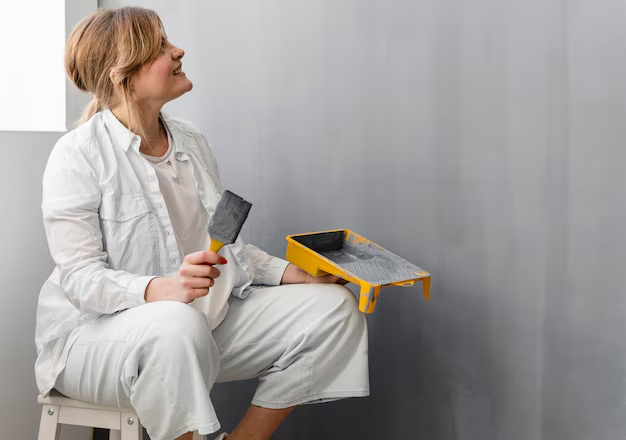Transform Your Refrigerator: A Step-by-Step Guide to Painting Your Fridge
Is your refrigerator looking a bit outdated or no longer matching your kitchen's aesthetics? Buying a new refrigerator can be costly, but repainting your existing one is a budget-friendly alternative. Refreshing your fridge with a coat of paint not only enhances its appearance but also gives your kitchen a personalized touch. Here's an authoritative guide on how to paint your refrigerator, complete with practical tips and detailed steps to ensure success.
🧰 Gathering Your Materials and Tools
Before embarking on your refrigerator makeover journey, it's essential to gather all necessary materials and tools. This preparation ensures a smooth process.
Materials:
- Specialty appliance paint or epoxy
- Primer (if required)
- Degreaser or mild detergent
- Sandpaper (120- to 220-grit)
- Painter's tape
- Plastic sheeting or drop cloths
Tools:
- Screwdriver
- Paintbrush and foam roller
- Spray gun (optional)
- Cleaning cloths
Why Specialty Appliance Paint?
Using specialty appliance paint is crucial as these are designed to adhere to metal surfaces and withstand the temperature changes common with appliances. This paint is also resistant to chipping and peeling.
🖌️ Preparing Your Refrigerator
Proper preparation is critical for achieving a durable and professional-looking finish.
Cleaning the Surface
Begin by thoroughly cleaning the refrigerator. Use a degreaser or mild detergent to remove grime and oils. Any residue left on the surface can prevent paint adhesion, leading to an uneven finish.
Disassemble Removable Parts
To ensure even coverage, remove handles, shelves, or any removable parts using a screwdriver. This not only protects these components from accidental paint splatters but also allows you to access tight spaces more effectively.
Sanding the Exterior
Lightly sand the refrigerator with 120- to 220-grit sandpaper to create a rough surface for the primer and paint to adhere to. Sand the appliance in even strokes, and be thorough in all sections, especially around corners and edges.
Masking Areas
Use painter's tape to cover areas you don’t want to paint, such as the door seals, handles, and the interior. Cover the surrounding area with plastic sheeting or drop cloths to isolate the workspace.
🎨 Painting Your Refrigerator
With your refrigerator prepped, you're ready to apply the primer and paint.
Applying Primer
Note: Not all paints require a primer. Read the directions on your paint can. If primer is recommended, proceed with this step.
- Ventilate the area well by opening windows or using a fan.
- Apply the primer using a foam roller for flat surfaces and a brush for edges and corners. Allow the primer to dry completely.
Painting Techniques
- First Coat: Apply the first coat of appliance paint using smooth, consistent strokes with a foam roller or a spray gun for an even finish. Avoid overloading the paint to prevent drips and runs.
- Second Coat: After the first coat dries, apply a second coat for uniform color and coverage. Ensure all areas have been thoroughly covered.
- Final Touches: Inspect the surface for any missed spots or imperfections, then touch up as needed.
Spray Gun Usage:
A spray gun can provide a professional finish, but practice first to get familiar with the tool. Maintain a consistent distance and speed when spraying.
⏳ Allowing For Adequate Drying Time
After painting, it's essential to let the refrigerator dry before reassembling. The drying process is critical for the paint to cure and become resilient.
- Initial Drying: Let the paint dry to the touch—usually a few hours.
- Curing Time: Wait at least 24 to 48 hours before reattaching any parts or moving the fridge.
⚡️ Reassembling Your Refrigerator
Once the paint has fully cured, you can reassemble the refrigerator components.
- Carefully remove painter's tape.
- Reattach handles and shelves.
- Conduct a final inspection to ensure everything is in place and secure.
📝 Essential Tips for a Painting Success
For a seamless painting experience, keep the following tips in mind:
- Work in Well-Ventilated Areas: To minimize fumes, ensure proper airflow during painting.
- Test Paint First: Always test your paint on a small fridge section or spare piece of metal to verify color and finish.
- Patience is Key: Allow adequate drying and curing time to achieve a smooth, durable finish.
🔍 FAQs About Painting Your Refrigerator
Can I paint my fridge if it's running?
Yes, but it’s advisable to turn it off and let it cool down before beginning the process. Painting an active fridge might make the surface warmer, affecting paint adherence.
Do I need to prime a stainless steel fridge?
If you're switching paint types significantly—for example, if metallic paint needs to adhere to stainless steel—primer is recommended to enhance adhesion.
Is there a benefit to using a spray gun over a roller?
A spray gun offers a more professional, even finish, but it requires practice and proper setup. Foam rollers are more user-friendly and practical for beginners.
📊 Quick Reference Cheat Sheet
| Task | Tools Needed | Key Tips |
|---|---|---|
| Clean Surface | Degreaser, Cloth | Remove all grime for better adhesion. |
| Disassemble Parts | Screwdriver | Helps in achieving smoother paint application. |
| Sand Surface | Sandpaper (120-220 grit) | Creates a proper surface for paint adherence. |
| Masking | Painter's Tape | Protects areas such as door seals and interiors. |
| Painting | Roller, Spray Gun | Multiple thin coats ensure uniformity and coverage. |
| Drying | Time and Space | Allow paint to cure properly for durability. |
Transformative Touches for Your Kitchen
Painting your refrigerator is a cost-effective way to refresh its look and your kitchen's ambiance. With patience, the right materials, and careful attention to detail, you can achieve a finish that mimics professional standards. This guide simplifies the process and empowers you to undertake an enjoyable DIY project that breathes new life into your appliances.
